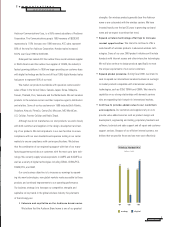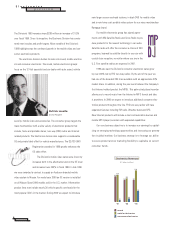Audiovox 1999 Annual Report Download - page 18
Download and view the complete annual report
Please find page 18 of the 1999 Audiovox annual report below. You can navigate through the pages in the report by either clicking on the pages listed below, or by using the keyword search tool below to find specific information within the annual report.
AUDIOVOX
16
the fair market value of the shares issued in the exchange and the fair
market value of the shares that would have been issued under the terms
of the original conversion feature for a total of $33,592.
Provision for Income Taxes
Income taxes are provided for at a blended federal and state rate of
40% for profits from normal business operations. During 1998, the
Company recorded $350 of tax benefit as a result of certain tax examina-
tions. In addition, the Company implemented various tax strategies, which
have resulted in lowering the effective tax rate. During 1997, the
Company had several non-operating events which had tax provisions cal-
culated at specific rates, determined by the nature of the transaction.
Liquidity and Capital Resources
The Company’s cash position at November 30, 1999 was approxi-
mately $3,871 below the November 30, 1998 level. Operating activities
used approximately $95,616, primarily from increases in accounts receiv-
able and inventory partially offset by an increase in accounts payable.
Even though accounts receivable and inventory have increased, days on
hand have decreased approximately 4% for both accounts receivable and
inventory. Investing activities used approximately $1,124, primarily from
the purchase of investment securities and the purchase of property, plant
and equipment, partially offset by the proceeds from the sale of invest-
ment securities. Financing activities provided approximately $92,884, pri-
marily from net borrowings under line of credit agreements.
On July 28, 1999, the Company amended and restated its credit
agreement with a group of lenders led by The Chase Manhattan Bank, as
administrative agent. The amended and restated credit agreement
increased the Company’s maximum borrowings available from $112,500 to
$200,000. Effective December 20, 1999, the Company amended the credit
agreement to increase its maximum borrowings to $250,000. The amended
and restated credit agreement contains covenants requiring, among other
things, minimum quarterly and annual levels of pre-tax income and net
worth. Under the amended and restated credit agreement:
• the Company may not incur a pre-tax loss in excess of $1,000 for any
fiscal quarter and may not incur a consolidated pre-tax loss in any two
consecutive fiscal quarters;
• the Company may not permit consolidated pre-tax income for the period
of two consecutive fiscal quarters ending on May 31, 2000, May 31,
2001, May 31, 2002, May 31, 2003 or May 31, 2004 to be less than
$1,500; or ending on November 30, 1999, November 30, 2000,
November 30, 2001, November 30, 2002 or November 30, 2003 to be
less than $2,500;
• the Company may not permit a consolidated pre-tax income for any fis-
cal year ending on or after November 30, 1999 to be less than $4,000;
• the Company must maintain a net worth base amount of $175,000, plus
50% of consolidated net income for each fiscal year ending on or after
November 30, 1999; and
• the Company must, at all times, maintain a debt to net worth ratio of
not more than 1.75 to 1.
The amended and restated credit agreement also contains restrictions
and limitations on, among other items, the Company’s ability to pay divi-
dends, repurchase stock and make capital expenditures or acquisitions.
Borrowings under the credit facility bear interest, payable monthly,
based on the annual interest rate publicly announced by The Chase
Manhattan Bank as its prime rate in effect at its principal office in New
York plus the applicable margin, which is based on the consolidated pre-
tax income for four consecutive quarters. The applicable margin presently
in effect is 0%. This margin will increase to .25% if consolidated pre-tax
income for four consecutive quarters falls below $4,000. The Company
may also borrow on a LIBOR basis plus the applicable margin. At present,
the margin above LIBOR is 1.50%, which will be reduced to 1.25% on
February 28, 2000. This margin will increase to 1.50% if the Company’s
consolidated pre-tax income for four consecutive quarters is equal to or
greater than $10,000 but less than $15,000, and to 1.75% if its consoli-
dated pre-tax income for four consecutive quarters is less than $10,000.
The margin will be 1.25% if consolidated pre-tax income for four consec-
utive quarters is equal to or greater than $15,000.
The Company’s ability to borrow under its credit facility is conditioned
on a formula that takes into account the amount and quality of its
accounts receivable and inventory. The Company’s obligations under the
credit agreement are guaranteed by its subsidiaries and are secured by its
accounts receivable. The amended and restated credit agreement expires
on July 28, 2004.
The Company believes that it has sufficient liquidity to satisfy its
anticipated working capital and capital expenditure needs for the reason-
able foreseeable future.
The Company also has revolving credit facilities in Malaysia to
finance additional working capital needs. As of November 30, 1999, the
available line of credit for direct borrowing, letters of credit, bankers’
acceptances and other forms of credit approximated $8,158. The
Malaysian credit facilities are partially secured by the Company under
one standby letter of credit totaling $1,300 and two standby letters of
credit totaling $5,320 and are payable upon demand or upon expiration of
the standby letters of credit on January 15, 2000 and August 31, 2000,
respectively. The obligations of the Company under the Malaysian credit
facilities are secured by the property and building in Malaysia owned by
Audiovox Communications Sdn. Bhd.
Impact of Inflation and
Currency Fluctuation
Inflation has not had a significant impact on the Company’s financial
position or operating results. To the extent that the Company expands its
operations into Latin America and the Pacific Rim, the effects of inflation
and currency fluctuations in those areas could have growing significance
to its financial condition and results of operations. Fluctuations in the for-
eign exchange rates in Pacific Rim countries have not had a material
adverse effect on the Company’s consolidated financial position, results
of operations or liquidity.
While the prices that the Company pays for the products purchased
from its suppliers are principally denominated in United States dollars,
price negotiations depend in part on the relationship between the foreign
currency of the foreign manufacturers and the United States dollar. This
relationship is dependent upon, among other things, market, trade and
political factors.
Management’s Discussion and
ANALYSIS OF FINANCIAL CONDITION AND
RESULTS OF OPERATIONS (continued) Audiovox Corporation and Subsidiaries
























